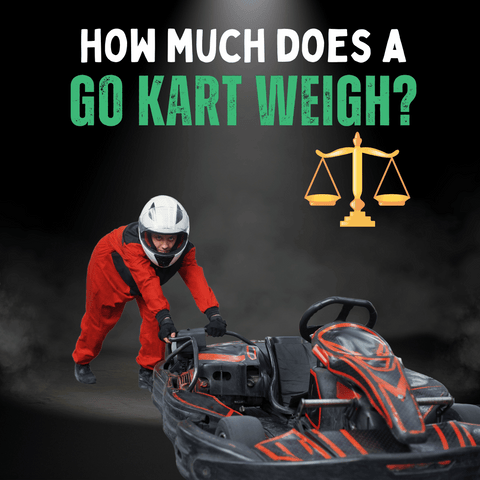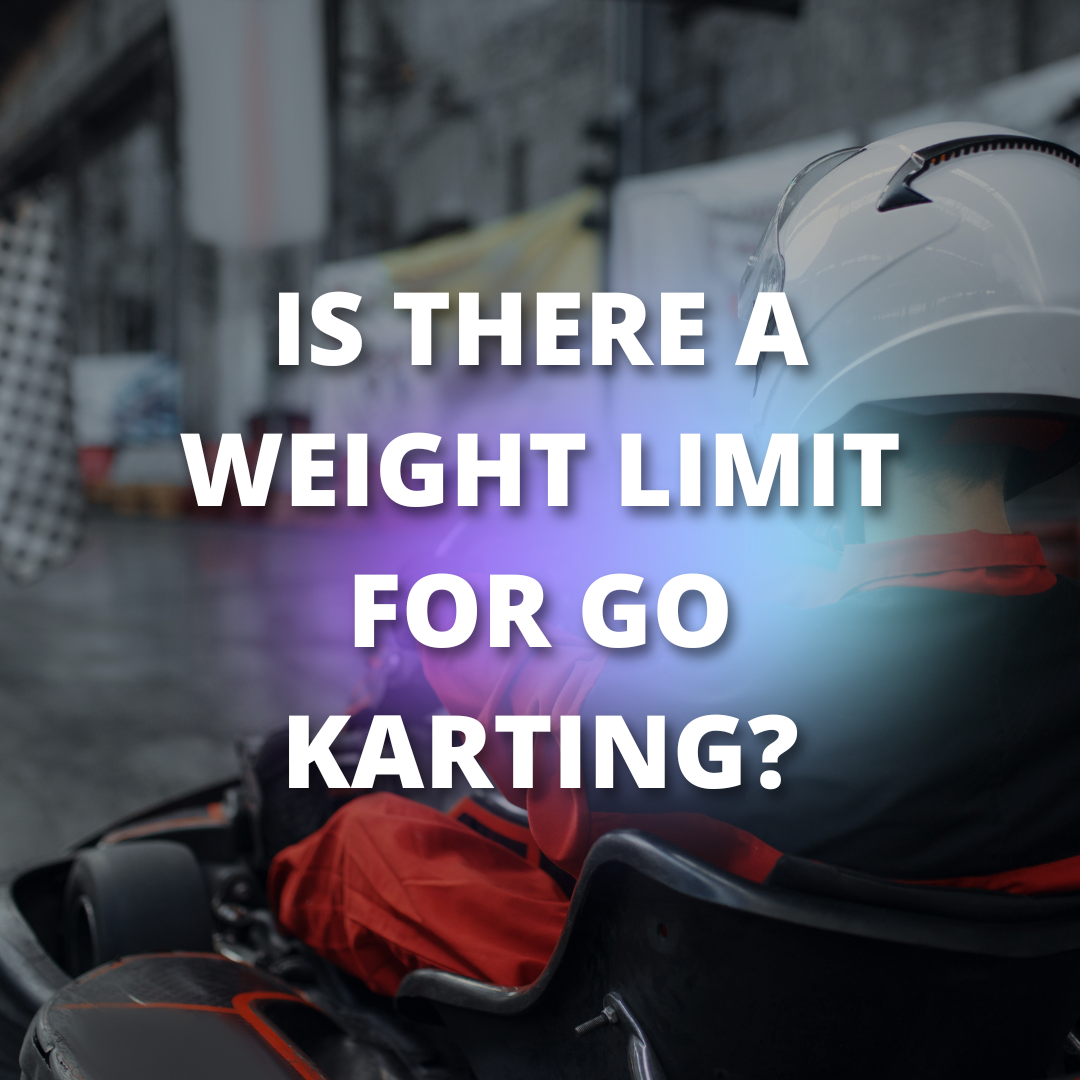Ever geared up for an exciting round of go-karting, only to find out you might exceed the weight limit?
You're not alone.
Why is there a weight limit? And, more importantly, how can it impact your go-karting experience?
Why is there a weight limit? And, more importantly, how can it impact your go-karting experience? 
Go-karting, although thrilling, isn't merely about hopping onto a kart and pressing the pedal to the metal.
Your weight plays a significant role in how your kart performs on the track.
It's not just about safety, though that's undoubtedly paramount; it can also affect your kart's speed and overall performance.
Sounds surprising?
Well, let's delve deeper into the world of go-karting and its weighty matters.
As we navigate through the intricacies of weight limitations in go-karting, you'll gain an understanding of its importance.
You'll see how it ensures safety and fairness, how it can affect your go-kart's control, and even impact your lap times.
But don't worry; the world of go-karting isn't all about restrictions.
With the right knowledge, you can make the most of your karting experience, ensuring safety and compliance and some serious fun.
Understanding the Basics: Weight Limits in Go-Karting
The Average Weight Limit for Go-Karts
Weight limits in go-karting are not universal and can vary. Most standard go-karts have an average weight limit between 160-170 pounds, which is roughly 72-77 kilograms.
This average stems from considering the typical weight of people, ensuring broad usability. However, this figure is not rigid and can change depending on the kart's model, engine capacity, and the track's safety guidelines.
Some karts are designed to support more weight, and some tracks may cater to heavier drivers.
Therefore, before you step on a track, it's best to verify the specific weight limits of the go-karts at the venue to ensure a safe and enjoyable ride.
Related: How Much Does a Racing Go-Kart Weigh?

Consideration of Equipment Weight
When considering weight limits, it's not just the driver's weight that's taken into account.
The weight of essential safety equipment like helmets and race suits also adds to the total weight the go-kart needs to handle.
In competitive racing scenarios, where weights might be added to the go-kart for balance or fairness (as discussed under 'weight ballasting'), this added weight is also part of the consideration.
Therefore, all these factors combined determine whether the total weight falls within the kart's safe operating limit.
Weight Limits for Adult and Professional Go-Karts
When we move on to adult go-karts, they generally come with a weight limit of between 250-300 pounds.
Professional karting has more stringent restrictions, with some championships setting the maximum weight limit at 190-200 lbs (86-90kg).
Hence, you should check with your local go-kart track for their specific weight restrictions.
|
Go-Kart Type |
Average Weight Limit (Pounds) |
Average Weight Limit (Kilograms) |
|
Adult Go-Kart |
250-300 lbs |
113-136 kg |
|
Child Go-Kart |
100-120 lbs |
45-54 kg |
|
Professional Racing Kart |
190-200 lbs |
86-90 kg |
Why Does Weight Matter in Go-Karting?
Safety and Comfort Concerns
Safety and comfort are two primary reasons behind the weight limit in go-karting.
When the weight exceeds the limit, it affects the overall performance of the kart, potentially making it harder to control.
For instance, it could make the kart more challenging to steer around corners, respond slower to brake inputs or make sudden manoeuvres more dangerous.
Overloading a kart also strains the engine and can lead to mechanical failures, such as a broken axle or a burnt-out engine. Moreover, a heavily loaded kart may have trouble navigating the track, potentially causing an uncomfortable, bumpy ride and even leading to injuries.
In addition to this, excessive weight might make the driver's seat uncomfortable and restraining, reducing the overall karting experience.
Therefore, adhering to the weight limit is essential to ensure a safe and comfortable karting adventure.
Ensuring a Fair Playing Field
In competitive go-karting, weight restrictions play a crucial role in ensuring fair play.
Kart racing is a sport of precision and skill where minute advantages can make a significant difference.
Lighter drivers generally have the upper hand in go-kart races due to better kart control and faster speeds.
A lighter kart can accelerate faster, has better fuel efficiency, and generally handles better, especially around corners.
This gives a clear advantage to lighter drivers over heavier ones, which might seem unfair in a competitive setting.
To counter this imbalance and level the playing field, competitive go-kart racing events often enforce weight limits or introduce weight divisions similar to other weight-division sports.
This means all racers in a particular category have a similar total weight (driver + kart), ensuring no one gets an unfair advantage due to their lighter weight.
This approach helps maintain the spirit of fair competition and allows the driver's skill to shine through.
Related: What is the Fastest Go Kart in the World?
Weight Ballasting in Competitive Go-Karting
In weight ballasting, weights are added to the kart of lighter drivers to match the heaviest driver in the race.
This practice ensures that all participants have an equal chance of winning the race, regardless of their individual weight.
The use of weight ballasting depends on the rules of the specific go-kart event or federation, and it's not typically used in casual go-kart racing.
Adding this piece of information provides an insight into how seriously fairness is taken in competitive go-karting and might encourage those apprehensive about their weight to participate, knowing that measures are in place to level the playing field.
The Impact of Excessive Weight on Go-Karting
Difficulty in Controlling the Go-Kart
When the weight threshold of a go-kart is exceeded, one of the immediate effects is the difficulty in controlling the kart.
The physics of handling a go-kart, much like any vehicle, changes with the increase in load.
The kart's responsiveness to steering inputs decreases, making it challenging to navigate tight corners or execute quick evasive manoeuvres.
Moreover, the stopping distance also increases as more weight means more momentum, requiring more force to stop or slow down the kart.
These factors together make controlling the kart difficult and can significantly increase the risk of accidents, especially at higher speeds or on challenging tracks.
The Impact on Experience and Lap Time
The enjoyment of go-karting is as much about the thrill of speed as it is about the skill of driving.
However, excessive weight can act as a spoiler here. A heavier kart, caused by a heavier driver or added weight, takes longer to accelerate.
The increased load on the engine makes it work harder to reach top speeds, thereby reducing overall speed.
Consequently, this not only slows down lap times but can also diminish the thrill and enjoyment of the activity.
Thus, maintaining an optimal weight can enhance the overall experience of go-karting, keeping it fun and competitive.
|
Weight Category |
Weight Range (Pounds) |
Weight Range (Kilograms) |
Impact on Lap Time |
|
Light |
Less than 150 lbs |
Less than 68 kg |
Every 22 lbs (10 kg) of extra weight could make the driver approximately 0.2 seconds slower per lap. |
|
Medium |
150-180 lbs |
68-82 kg |
The expected lap time for a 160 lbs (73 kg) driver might be 31.2 seconds, while for a 180 lbs (82 kg) driver, it could be 31.6 seconds. |
|
Heavy |
More than 180 lbs |
More than 82 kg |
A driver who is 121 lbs (55 kg) heavier could be around 3.5 seconds slower over a 39-second lap. |
Please note these figures are estimates, and the actual impact on lap times can vary depending on several other factors, including track layout, kart model, and driver skill.
Risk of Overloading the Go-Kart
Just like any vehicle, a go-kart is built to withstand a specific maximum weight.
When that limit is exceeded, it's considered overloaded, leading to potential issues.
Overloading puts excessive strain on the go-kart's mechanical parts, such as the axles, engine, and brakes.
This could result in the premature failure of these components and potentially cause the kart to break down mid-race.
Besides the disappointment of an interrupted ride, the sudden malfunction of a kart, especially at high speeds, poses a significant risk of accidents and injuries.
Thus, staying within the weight limit is crucial not only for the fun of the race but also for the safety of the drivers.
If you're worried about this, then knowing how much a go kart costs will certainly be of interest to you.
In Summary: Balancing Enjoyment and Safety
To wrap things up, weight limits in go-karting may initially seem like an inconvenience. However, understanding their significance and rationale is key to a safe and enjoyable go-karting experience.
These limits, which vary across tracks and kart models, are in place to ensure your safety and comfort, to level the playing field in competitive settings, and to protect the go-kart from potential damage.
Remember, exceeding these limits can compromise the control of the go-kart, affect your overall karting experience, and even risk a kart malfunction.
So, the next time you're revving up for a go-karting session, make sure you're aware of the weight limits and the role they play in creating a fantastic, thrill-packed go-karting adventure.
FAQs
Are there specific types of go-karts designed for heavier drivers?
Yes, there are specific models of go-karts designed to accommodate heavier drivers. These karts generally have a more robust build and a more powerful engine to compensate for the additional weight. However, availability may vary based on the track or rental service, so it's advisable to check in advance.
Does the weight of a child affect their ability to drive a go-kart?
Children's go-karts are typically designed with a lower weight limit to account for their lighter weight and smaller size. If a child is significantly lighter than the average weight for their age, it may affect their ability to control the kart effectively. If you're unsure, it's best to discuss this with the staff at the go-kart track, as they can provide guidance based on the specific karts they have available.
Can I still participate in go-karting if I'm close to the weight limit?
If you're close to the weight limit, you should still be able to participate in go-karting. However, you might experience a slower ride compared to lighter drivers. If you're participating in a competitive race, there might be weight classes or adjustments made to ensure fairness. Always check with the go-kart facility to understand their specific rules and policies.






Share:
From Clumsy to Confident: How to Shift Gears on a Motorcycle Like a Pro
What Is A Stator on A Motorcycle? How Do Stators Work?